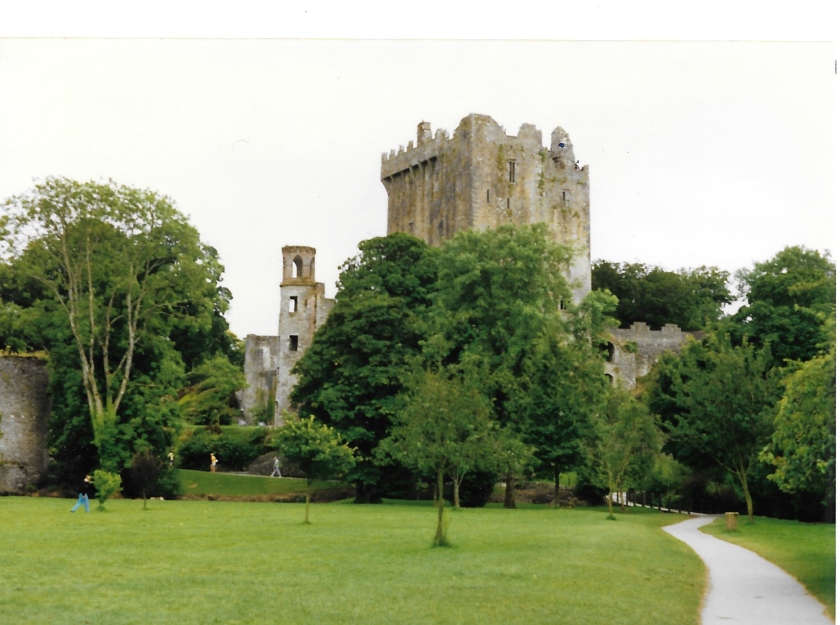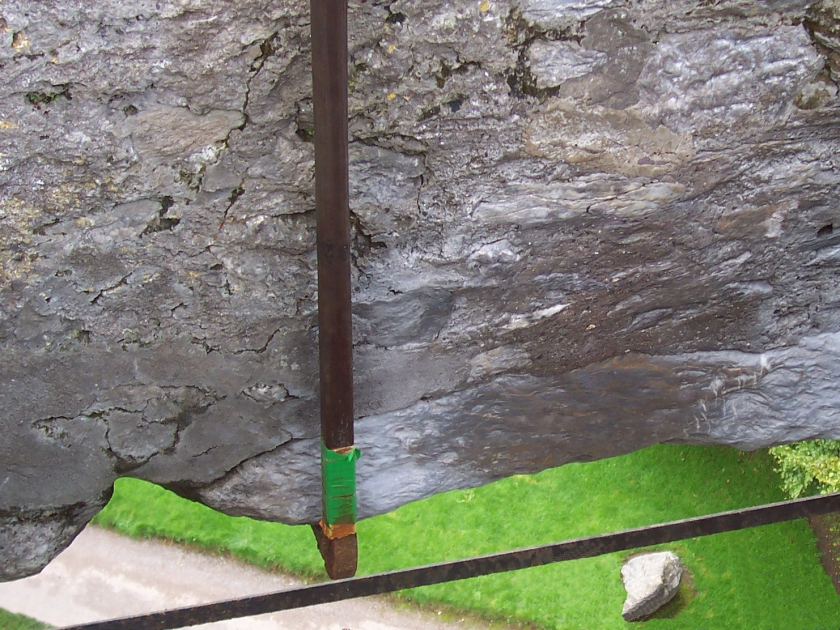 As legends go, it’s a pretty weird one. The famous blarney stone is a large block of limestone set into the far wall of a machicolation high up in Blarney Castle. (A machicolation is a box-like, floorless opening in the battlements, used to pour hot oil or other nasty stuff on intruders.) They* say that if you climb to the top of the ruined keep of Blarney Castle, lay down and hang over the edge backwards far enough to kiss that block of limestone set into the battlements, you’ll be blessed with the gift of gab. You’ll be able to regale audiences with your silvered tongue and eloquence, with the fluency and perhaps even the loquacity to rival the best orators.
As legends go, it’s a pretty weird one. The famous blarney stone is a large block of limestone set into the far wall of a machicolation high up in Blarney Castle. (A machicolation is a box-like, floorless opening in the battlements, used to pour hot oil or other nasty stuff on intruders.) They* say that if you climb to the top of the ruined keep of Blarney Castle, lay down and hang over the edge backwards far enough to kiss that block of limestone set into the battlements, you’ll be blessed with the gift of gab. You’ll be able to regale audiences with your silvered tongue and eloquence, with the fluency and perhaps even the loquacity to rival the best orators.
Having kissed the stone twice myself, I can tell you first hand that the legend is overstated. I’m no orator, and while I can tell a good story, I do better in print than in person.
But If it’s all just blarney, why do visitors flock to Blarney Castle every year? The history behind the blarney stone is as nebulous as its purported virtues. One story claims the Cliodhna /Kleena/, a major goddess in the Irish pantheon of the Tuatha de Danann, sometimes known as the Queen of the Banshees or the queen of the Sidheog (fairy women), was involved. Lord MacCarthy, the builder of Blarney castle in 1446 asked for Cliodha’s help to win a lawsuit. She advised him to kiss a stone on his way to court. He did and then won his case through his eloquent tongue. He then used the special stone in the building of his castle.
A hundred years later, Queen Elizabeth complained of the “blarney” because she could not complete any negotiation with a later MacCarthy, the lord of Blarney Castle, because of his non-committal diplomacy, or the ability to promise little or nothing with a lot of eloquence. While it’s true that Cormac MacCarthy managed to sweet-talk Queen Elizabeth without signing over his lands, whether his eloquence and wit came from the stone is questionable.
Another early legend says the stone was actually Jacob’s pillow and was brought to Ireland by the Prophet Jeremiah. Some say it was part of the ‘speaking stone’, the throne where Irish kings were crowned at the hill of Tara. Still others claim it was the stone Moses struck in the desert on God’s command to bring water to his people. It’s even said the stone was the pillow on which St. Columba died.
Only slightly more plausible is the legend of the stone’s origin in Scotland. In 1314, before the current Blarney Castle was built, Cormac McCarthy supposedly sent several thousand men to aid Robert the Bruce, and in return Robert gave McCarthy half of the stone of scone or stone of destiny, where Scottish kings were crowned.
For the record, all of the legends claiming the stone came from somewhere else have been proved pure blarney by scientific evidence showing the stone to have originated in Ireland.
In fact, the Oxford English Dictionary’s first recorded use of the term ‘blarney’ is from 1803, well after Cliodhna and all the early MacCarthys slid into oblivion. Perhaps the idea of blarney as lies, half-truths, and fabrications all wrapped up in charm came from Lady Blarney, a smooth-talking flatterer in Oliver Goldsmith’s Vicar of Wakefield, published in 1766.
Whatever the origins of the stone and the legends surrounding it, the history of Blarney Castle is well-known. The original Blarney castle was a wooden structure built about 1200 AD outside the village of Blarney. That first building has entirely disappeared. In 1210, a stone structure was built on the site. This lasted until 1446, when it was destroyed, and the current building was constructed by Cormac Laidir MacCarthy. The castle changed hands a number of times in the next several centuries, and eventually fell into disrepair, especially after Blarney House was built in 1874 as a more modern and convenient lodging for the family
Though it is now in ruins, Blarney Castle and the surrounding gardens are fascinating. It’s best to visit early, before the crowds come in. Narrow stone steps, worn smooth with age and use, spiral upward in the dark tower and emerge at the top of the keep. The view over the battlements in the early morning as the mists are rising is as magical as any stone visitors come to kiss. Some of the rooms are still open. Passing through bare stone hallways and into empty rooms, it’s easy to imagine the footsteps of the people who lived here hundreds of years ago. In my mind’s eye, I could almost see the tapestries warming the walls, the tables laden with roasted game and rich pies, the servants hurrying to fill another goblet. It’s as if the stones are whispering their stories, if only we take the time to listen.
Equally enchanting and steeped in legends are the sixty acres of gardens and parklands surrounding the castle. In the Rock Close for instance, moss-covered rocks and twisted trees line the meandering paths. In the hush, we could hear the trickle of a waterfall, and when I closed my eyes, I imagined the brush of fairy wings on my cheek. The very air seems steeped with magic. Huge boulders loom over paths winding around an ancient dolmen, a druid’s cave, a sacrificial altar, a witch’s kitchen, and a stone circle. (To be sure, the druidic connections were ascribed by the romantic Victorians.)
The stone circle called “The seven sisters,” has nine huge stones, seven standing and two toppled. In one legend the kind of Munster had seven daughters and two sons. When both sons were killed in a battle, the mournful king ordered his men to knock down two of the stones to commemorate his boys.
Another winding path leads to a set of rough stone steps called the wishing steps. According to the legend, anyone who climbs the steps to the stone archway, backwards and with eyes closed, thinking only of their wish, will be grant that wish within a year and a day by the Blarney witch.
From ancient Druids to magic stones, from wishing steps and witches to kings of old, Blarney is a place full of stories that stir the imagination. It’s a place to make us believe, if only for a moment, that all the legends are true.

*”They” being the anonymous gossip mongers who spread rumors that turn into legends.




One thought on “Beyond the Blarney”